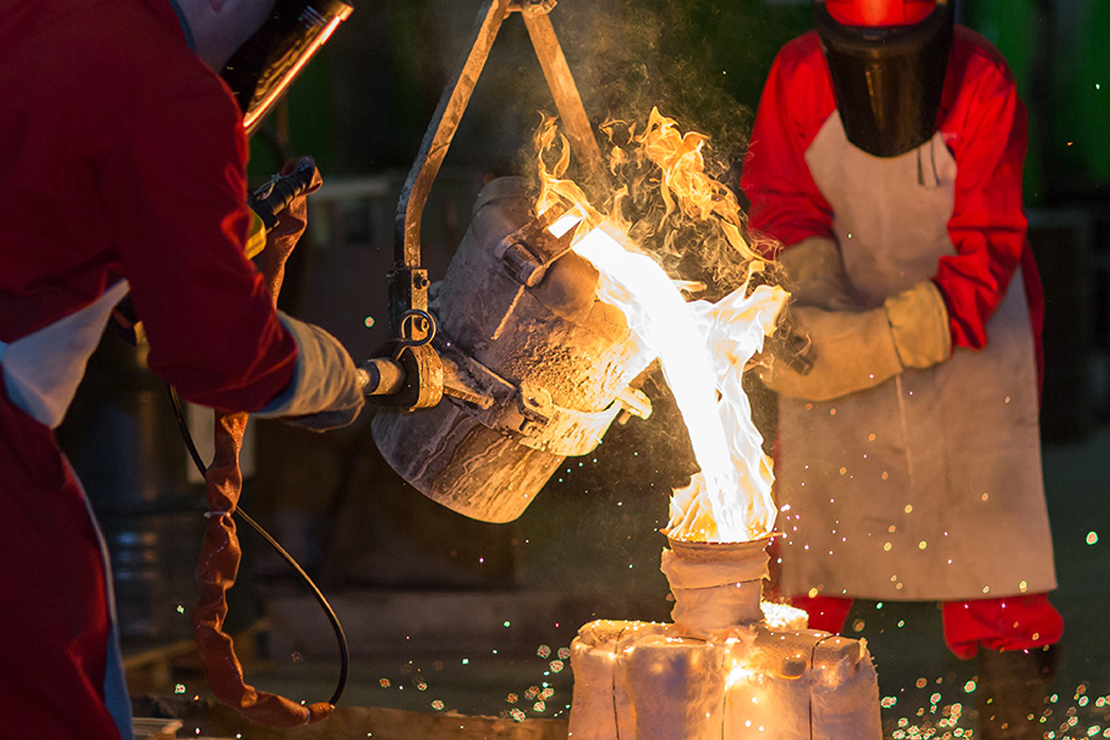Investment casting
Contents |
[edit] What is investment casting?
Investment casting is also known as the ‘lost wax’ process and is one of the oldest known metal casting methods where molten metal is poured into a mould. Investment casting dates back 5,000 years and can be traced back to Ancient Egypt and China, where patterns were formed out of beeswax to create jewellery or other ornaments. Today, high-technology waxes, refractory materials and a large range of alloys are used.
[edit] What is the investment casting process?
There are several steps involved in the investment casting process:
- First, a pattern or replica of the part that will be cast is created by injecting wax into a die. The pattern is created as one piece.
- Then, several wax patterns are compiled into an assembly known as a gating system or ‘tree’, which allows molten metal to flow into the mould cavity later.
- The assembly is submerged in high-grade ceramic slurry (the investment stage).
- An additional coating of course ceramic particles up to 10mm thick are built-up while the assembly is still wet.
- The wax is melted from the dry mould and leaves a thin-walled, hollow ceramic shell.
- Moulds are fired to remove any remaining wax and add durability to the final mould, a step which can use temperatures of up to 1,000 degrees C.
- Molten metal is poured within the still-heated moulds. These are heated to allow for better dimensional accuracy and tolerances as low as 0.76mm.
- The cooled shell mould is broken or cut open to reveal the casting.
- The final part is finished using processes such as fettling, grinding, sandblasting, heat treatments and others.
[edit] The benefits of investment casting
This process offers benefits including:
- It allows for the manufacturing of intricate and complex forms.
- It ensures parts have smooth surfaces with no parting lines.
- A vast range of alloys can be used, including carbon steel, stainless steel and those of aluminium and bronze. Materials that are difficult to machine can be used in this process too.
- It offers good dimensional accuracy to components.
- Clients can choose both low- and high-volume manufacturing.
- The cost of production is reduced, since both assembly and waste are minimal.
- It is possible to add names, logos or other information to the parts.
- Parts have a high level of accuracy, repeatability and integrity.
[edit] When to use investment casting?
This process is popular worldwide when it comes to manufacturing parts with high accuracy, repeatability and cast integrity. It is used in a variety of industries and sectors, from oil and gas to automotive, aerospace and defence.
The investment casting process can be used when:
- Clients require a medium- to high-volume of orders – virtually no tool wear, so it is ideal for consistency and repeatability. The process also saves time and labour costs, since it eliminates the need for secondary machining.
- High precision parts are required – investment casting allows for a great degree of precision, as well as great dimensional accuracy, complex shapes and the addition of details.
- Clients need different sizes – the process allows for the creation of parts that meet the demanding standards of a multitude of industries. These standards include size: investment casting produces parts that can weigh a few grams up to several kilos.
- There is a need for a variety of materials – with investment casting, parts can be cast in both ferrous and non-ferrous metals, as well as an array of alloys.
- Parts need to have smooth surface finishes – investment casting is a process that allows for the manufacturing of components with finer quality finishes, as it can achieve near net shapes with little to no machining.
--Dean Group 09:57, 16 Oct 2019 (BST)
[edit] Related articles on Designing Buildings Wiki
Featured articles and news
RTPI leader to become new CIOB Chief Executive Officer
Dr Victoria Hills MRTPI, FICE to take over after Caroline Gumble’s departure.
Social and affordable housing, a long term plan for delivery
The “Delivering a Decade of Renewal for Social and Affordable Housing” strategy sets out future path.
A change to adoptive architecture
Effects of global weather warming on architectural detailing, material choice and human interaction.
The proposed publicly owned and backed subsidiary of Homes England, to facilitate new homes.
How big is the problem and what can we do to mitigate the effects?
Overheating guidance and tools for building designers
A number of cool guides to help with the heat.
The UK's Modern Industrial Strategy: A 10 year plan
Previous consultation criticism, current key elements and general support with some persisting reservations.
Building Safety Regulator reforms
New roles, new staff and a new fast track service pave the way for a single construction regulator.
Architectural Technologist CPDs and Communications
CIAT CPD… and how you can do it!
Cooling centres and cool spaces
Managing extreme heat in cities by directing the public to places for heat stress relief and water sources.
Winter gardens: A brief history and warm variations
Extending the season with glass in different forms and terms.
Restoring Great Yarmouth's Winter Gardens
Transforming one of the least sustainable constructions imaginable.
Construction Skills Mission Board launch sector drive
Newly formed government and industry collaboration set strategy for recruiting an additional 100,000 construction workers a year.
New Architects Code comes into effect in September 2025
ARB Architects Code of Conduct and Practice available with ongoing consultation regarding guidance.
Welsh Skills Body (Medr) launches ambitious plan
The new skills body brings together funding and regulation of tertiary education and research for the devolved nation.
Paul Gandy FCIOB announced as next CIOB President
Former Tilbury Douglas CEO takes helm.
UK Infrastructure: A 10 Year Strategy. In brief with reactions
With the National Infrastructure and Service Transformation Authority (NISTA).
























